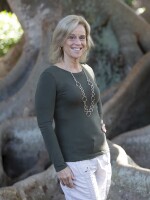For at least 20 years, museum visitors have lined up to see the work of Japanese artist Yayoi Kusama.
Her immersive "infinity mirror rooms" of colored lights and polka dots have made her the world’s most Instagrammed artist.
But her career may have not exploded in such a spectacular fashion if she hadn't sought advice from Georgia O' Keeffe -- one of the greatest artists of the 20th century, known for her images of flowers and the Southwest.
Kusama first encountered O’Keeffe’s work through an illustration in a book she found in a secondhand bookshop in her hometown of Matsumoto in the years following World War II.

In the 1950's, the young artist was living in rural Japan when she wrote a letter seeking advice from O'Keeffe, who she had never met but admired from afar.
A blown-up version of that letter dated Nov. 15, 1955, is displayed in the exhibition.
David Berry, the chief curator at Marie Selby Botanical Gardens, says much to Kusama's surprise, O'Keeffe responded.
"And that leads to a number of years of exchange by letter across the Atlantic,” he said. "And then ultimately, Kusama moves to New York and it's really there that she begins to establish the foundations of her ultimate superstardom in the art world."

In a handwritten note that still exists in archives, O’Keeffe advised Kusama to the difficulties of art world success and says that if she was serious about pursuing that path, she must move to New York.
Berry says there’s no sort of definitive explanation as to why the famous O’Keeffe chose to respond, but it seems as though she recognized something in Kusama as a young female artist trying to make her way, which resonated on a personal level.
He adds that O'Keeffe was also very much interested in Japanese art and culture.
“She had been exposed to Japanese style painting which is referred to as Nihongo style painting as part of her artistic training,” he said. “And her interest in Japanese culture can be seen in everything from her style of dress to the books on her bookshelf at home, and some of her hobbies and practices. She had an interest in bonsai and Japanese style gardening, so the fact that this letter arrives from someone from Japan, I have to think, was intriguing to O’Keeffe.”

Berry says the two artists only met in person once, but the mentorship was profound for both.
"A lot of the material we feature in the show is in O'Keeffe's archive, but it relates to Kusama, so she's sort of like a grandparent keeping newspaper clippings of their grandson or granddaughter," he said.
Many of those items along with other artifacts are displayed inside Selby’s Museum of Botany and the Arts.
Kusama’s original work, a four-panel acrylic painting titled “Infinity of Dots,” is also on view.
Horticultural displays throughout the gardens include desert-like landscapes inspired by O'Keeffe and floating glass globes suggestive of Kusama's signature polka dots.

Berry says both artists were drawn to nature.
"Kusama was born to a very well-to-do Japanese family that owned a plant nursery so she described having grown up in the fields of the nursery sketching flowers,” he said. “O'Keeffe was born on a dairy farm in Wisconsin, also exposed to nature from an early age and immerses herself in the natural environment of New Mexico where she lives her later life."
Each year, Selby’s horticultural team looks to the artists’ work to create their own interpretations without trying to overtly copy them.
"That’s why you won’t see actual polka dots in the displays, but there are plenty of circles and other arrangements that suggest them," said Mike McLaughlin, Selby's senior vice president for horticulture.
Garden vignettes include hundreds of round cacti hanging upside down under a canopy, to circular planters bursting with red bromeliads overlooking the bay. The planters sit on a bed of crushed white shells as an homage to Kusama’s series "Infinity Dots."
Throughout the exhibition are quotes from O’Keeffe, who died in 1986 at her New Mexico ranch, and Kusama, who is still working at 94.
One featured is an excerpt from Kusama’s autobiography, “Infinity Net,” where she wrote about O'Keeffe’s influence. It reads, “if she had not so kindly answered my clumsy and reckless letter, I am not sure I would ever have made it to America."
"Yayoi Kusama: A Letter to Georgia O’Keeffe" at Marie Selby Botanical Gardens in Sarasota is on view through June 30.




